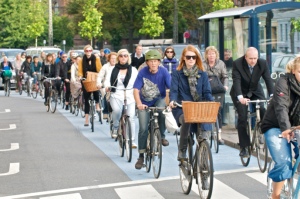While I was reading The Carbon Efficient City, actually as soon as I read the title, I remembered the cities, such as Copenhagen, Denmark and Malmo, Sweden, the cities I have actually been to 2 years ago through the university’s study travel program. I was completely blown away by the efficiency of transportation, pedestrian-only streets and so on. Then the book, in the beginning, indeed mentioned these two cities and Vancouver, BC, and Portland, which I all have been and lived in for years, as great examples of carbon efficient cities. This truly involved me into the reading because I could relate
myself into the great concept of the carbon efficient city from my own experience.
Above all great things about Copenhagen, one thing truly stood out for me in those cities: bicycle planning. The careful and in-depth planning of Jon Gehl and this company for many years, resulted in a city where a child to elders can bike literally any time of a day with comport. Great system resulted in reduction of cars thus great reduction of carbon emission. Last time I checked, Copenhagen was the city where the most percentage of people go to work by bicycle in the world. Being there for 2 weeks and on a single-geared bicycle for the entire time, I personally understood and felt how easy, comfortable, and fast it was to ride bicycle in the city. Writing this just made me want to go back to the city, just for few days and that was how enjoyable the whole bicycle experience was.
Then I thought about Seattle, the city where now I reside and the city I start to care. I am seeing bicycles everyday commuting to work and in the neighborhoods. There has been more bicycle lanes installed in streets more and more; however, I do not see many elders or kids using the bicycle lanes or trails, such as Burke-Gilmann. Frankly, there are not that many people even in my age who commute to school by bicycles. And, in my opinion, I do not see the bicycle population being deastically increased even with these various efforts in Seattle. Why? Because of the hills of Seattle.
Of course Copenhagen has been a very successful bicycle city because of great city planning;however, the more important factor, in my opinion, is how flat the entire city of Copenhagen is. That makes bicycling in the city so much easier for anybody to commute most part of the city. Seattle is different. I see so many obstacles when I look at the overall topology of Seattle. So many extremely-sloped roads make less desirable for people of all ages to enjoy bicycling. And this made me think that does any of the changing or shifting the existing systems or regulations in Seattle make a drastic change in bicycle population? One very primitive way I thought was to make the entire topography of Seattle flatter, which will cost a lot of money to do that. Maybe comparing bicycling in Copenhagen to Seattle is a bit too harsh for Seattle. But I thought this was just an interesting notion which is that, in some of these extreme conditions, changing regulations or framework might not work at all, and you will have to find another ways to combine to get better systematic results. After all, nothing is easy.

